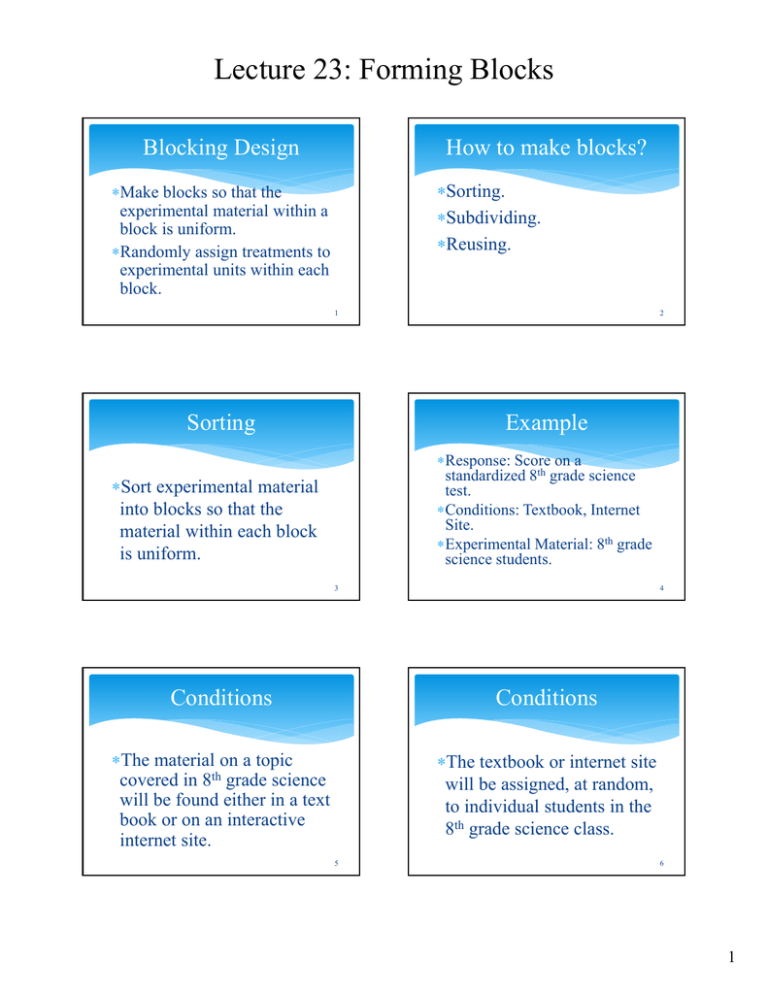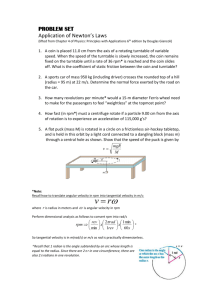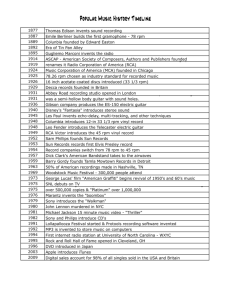Lecture 23: Forming Blocks Blocking Design How to make blocks?
advertisement

Lecture 23: Forming Blocks Blocking Design How to make blocks? Sorting. Subdividing. Reusing. Make blocks so that the experimental material within a block is uniform. Randomly assign treatments to experimental units within each block. 1 Sorting 2 Example Response: Score on a standardized 8th grade science test. Conditions: Textbook, Internet Site. Experimental Material: 8th grade science students. Sort experimental material into blocks so that the material within each block is uniform. 3 4 Conditions Conditions The material on a topic covered in 8th grade science will be found either in a text book or on an interactive internet site. The textbook or internet site will be assigned, at random, to individual students in the 8th grade science class. 5 6 1 Lecture 23: Forming Blocks Experimental Material Experimental Material There will be a lot of variation in the 8th grade science students due to: Sort students according to their scores on the science portion of the Iowa Test of Basic Skills taken in 7th grade. Science knowledge Ability to take standardized tests. 7 Blocks 8 Blocks Students with two highest scores. Students with the next two highest scores. Etc. Students with the two lowest scores. Within each block the two students will be similar in terms of science knowledge and test taking ability. 9 10 Random Assignment Sorting Within each block, assign the textbook to one student and the internet site to the other student. This can be done with a flip of a coin. When using sorting to create blocks you should sort on an outside variable that is related to the response in your experiment. 11 12 2 Lecture 23: Forming Blocks Sorting Subdividing Sorting 8th grade students on height would not be a good way to form blocks. Height of a student should not affect how a student scores on a standardized test on science. Take large chunks of uniform material and divide it into smaller pieces. 13 Example 14 Experimental Material Response: Surface roughness for a hole. Conditions: Speed of the drill. Bars of carbon steel are made by melting iron ore in a furnace, adding carbon to strengthen the steel and pouring the molten steel into molds. 500 rpm, 1000 rpm, 1500 rpm Experimental material: Bars of carbon steel. 15 16 Experimental Material Experimental Material Several bars can be made from each heat of steel. Different heats can produce bars with quite different characteristics, e.g. hardness. A single bar will be quite similar from one part to the next. Different bars can be quite different. 17 18 3 Lecture 23: Forming Blocks Subdivide the bars Conditions Randomly assign the three speeds to pieces of each bar. Each bar is drilled with all three speeds. 1000 rpm 500 rpm 1500 rpm 1500 rpm 500 rpm 1000 rpm 500 rpm 1500 rpm 1000 rpm 19 Subdividing Reusing We could actually divide each bar into separate pieces. 1000 rpm 500 rpm 20 Reuse the experimental material so that each piece of experimental material experiences all the treatments in a random order. 1500 rpm 21 Example 22 Reusing Material Each person will sit in a chair and rise to a standing position. Each person will do this three times, once with each foot position. The order of the three foot positions will be randomized for each person. Response: torque on knee Conditions: placement of feet Feet back, feet neutral, feet staggered Experimental Material: men who have had knee replacement. 23 24 4 Lecture 23: Forming Blocks Comment Another Example When you can reuse material you have the most uniformity within a block (the individual) because all outside variables (height, weight, strength, age, etc.) are exactly the same within a block (the individual). Response: number and size of skin cancer tumors. Conditions: skin cream, skin cream with caffeine. Experimental Material: hairless mice. 25 Conditions 26 Response A mouse’s skin is coated with the cream or the cream containing caffeine. The mouse is then exposed to large doses of ultraviolet radiation (tanning bed). After exposure to the ultraviolet radiation, the number and size of skin cancers are noted and measured. 27 28 Reusing? Forming Blocks Once a mouse is exposed to the ultraviolet radiation, it has skin cancer and so cannot be reused with the other treatment. Could sort mice into pairs according to genetics, size, gender, etc. Could subdivide mice, put cream on half and cream with caffeine on the other half. 29 30 5




